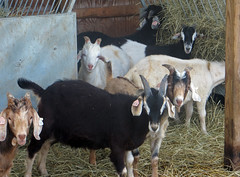For the third year in a row, University of Maryland Extension is conducting a study to compare the performance and carcass characteristics of meat goat bucklings fed in a pen vs. those raised on pasture.
The pen-fed goats (n=15) are being fed a hay and grain diet. Hay is available free choice in hay racks while grain (whole barley) is hand-fed once per day based on appetite. Free choice minerals are also available.
The pasture-fed goats (n=15) are grazing alongside the bucks in the 2013 Western Maryland Pasture-Based Meat Goat Performance Test. They will not receive any supplemental feed, but have access to free choice minerals.
After a 13-day adjustment period, the goats will consume their respective diets for 84 days. They will be handled bi-weekly to collect data and fecal samples. At the conclusion of the feeding period, all of the goats will be harvested to collect carcass data. A sample of the longissimus dorsi muscle will be used to determine fatty acid composition of the meat.
All of the goats in this year's study are from the same farm. They are all Kiko.Their average starting weight was 51.6 lbs.
The 2013 study is being funded by the Maryland Grain Producers Utilization Board, which also funded the 2012 study.
Meat Goat Carcass Evaluation
 |
| Goats in pen (n=15) |
The pasture-fed goats (n=15) are grazing alongside the bucks in the 2013 Western Maryland Pasture-Based Meat Goat Performance Test. They will not receive any supplemental feed, but have access to free choice minerals.
 |
| Goats on pasture (n=15) |
All of the goats in this year's study are from the same farm. They are all Kiko.Their average starting weight was 51.6 lbs.
The 2013 study is being funded by the Maryland Grain Producers Utilization Board, which also funded the 2012 study.
Meat Goat Carcass Evaluation

No comments:
Post a Comment